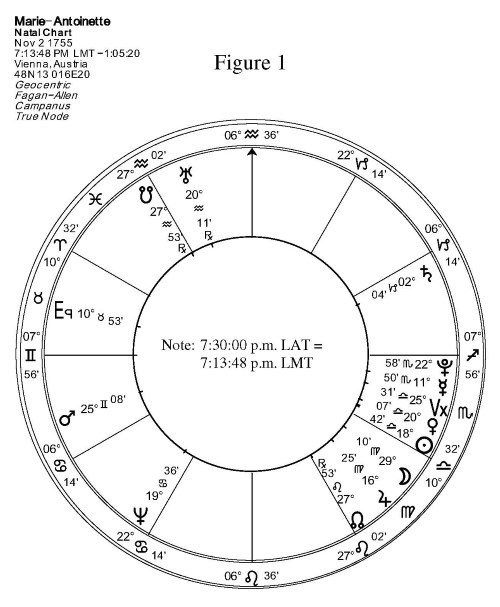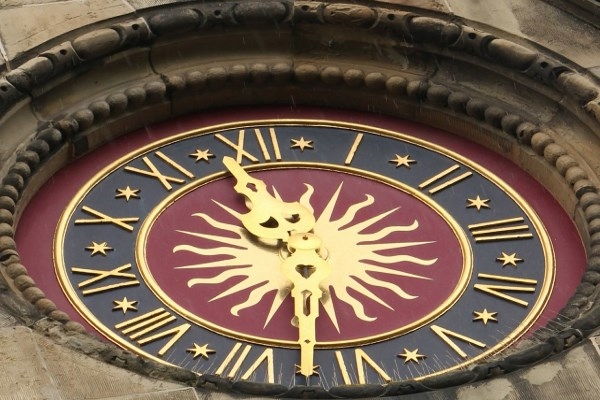By: Kenneth Bowser
According to her family records, Maria Antonia Habsburg was born November 2, 1755 at 7:30 p.m. in Vienna, Austria. If a horoscope is cast for these data using 7:30 p.m. Central European Time, it will not produce the right horoscope because clocks in 1755 were not set to that time standard. Central European Time and the other time zones used today were not employed until late in the Nineteenth Century.
If the local mean time of Vienna is substituted for Central European Time, Maria’s horoscope will still be wrong because local mean time was not used anywhere as a civil standard until 1780 at Geneva, Switzerland, and nowhere else until London adopted local mean time in 1792; the rest of England did not follow suit at once..
In 1755 wherever a mechanical clockwork was in place in Western Civilization as a civil standard, and almost surely throughout the Islamic world as well as India, it was set to the Sun. Sun time or sundial time is more commonly known in astronomical and astrological parlance as local apparent time. The critical difference between local mean time and local apparent time is that the former keeps to a mean rate and the latter does not. The most obvious manifestation of this difference is that in local mean time reckoning, the clock usually has only an approximate relation to true noon, whereas by local apparent time reckoning, noon o’sun is always exactly noon o’clock. Local mean noon and local apparent noon coincide four times per year, yet local mean time severs the constant relationship between a clock and the Sun.
In the case of Maria Antonia, better known by the French rendering of her name, Marie- Antoinette (queen of France and wife of Louis XVI), the difference between 7:30 p.m. local apparent time and 7:30 p.m. local mean time is sixteen minutes and twelve seconds. The local mean time equivalent of 7:30 p.m. local apparent time is sixteen minutes and twelve seconds earlier, or 7:13:48 p.m. local mean time.
 While these are equivalent times in different systems of reckoning, the difference must be taken into account to view a horoscope from this period, as a contemporary astrologer would have calculated it. This local mean time value, 7:13:48 p.m., is the time which will give her correct horoscope (see figure one). Since most of us use computer programs, which will not recognize an entry rendered in terms of local apparent time, one must know what to do with it. With very few exceptions, modern astrologers relegate every horoscope, which predates the modern era to local mean time status without converting it from local apparent time to local mean time. This article explains how to convert back and forth from mean time to apparent time with related information about time.
While these are equivalent times in different systems of reckoning, the difference must be taken into account to view a horoscope from this period, as a contemporary astrologer would have calculated it. This local mean time value, 7:13:48 p.m., is the time which will give her correct horoscope (see figure one). Since most of us use computer programs, which will not recognize an entry rendered in terms of local apparent time, one must know what to do with it. With very few exceptions, modern astrologers relegate every horoscope, which predates the modern era to local mean time status without converting it from local apparent time to local mean time. This article explains how to convert back and forth from mean time to apparent time with related information about time.
Why Bother with Local Apparent Time?
It is important to observe local apparent time (LAT) for the era during which it was in effect for the same reason that astrologers are careful to note what time standard was in effect or if daylight saving time was observed for a modern birth or event: for the sake of general accuracy. For Marie-Antoinette the difference between using the correct time standard, LAT, and the wrong one, local mean time (LMT), is four degrees and fifteen minutes of arc at the mid- heaven and three degrees and forty minutes on the ascendant.
This may seem trifling until it is recognized how quickly signs of short ascension rise in high latitudes north and south. At some heavily populated latitudes all or most of a sign can rise in only sixteen minutes. Using LMT as the time convention for periods before it came into use can give the wrong rising sign, and, depending on one’s preferred house system, planets may be positioned in the wrong house.
Primary directions being especially time sensitive will not give the right symbolism at the right time for angles (i.e. horizon and meridian) which are only slightly wrong. Likewise, the angles of the secondary progressions will be incorrect if the wrong time standard is observed; the position of the Moon will be wrong, in the case of Marie-Antoinette, by ten minutes of arc.
That doesn’t sound like much, but since the Moon often takes about twenty minutes of time to move ten minutes of arc, using the wrong time standard will mean that the angles of her lunar returns will often be more than five degrees in error.
Finally, the tertiary progressions will not be accurate if the wrong time is used. All of these problems can cause rectification attempts to be inflicted on charts that don’t need them if the wrong system of time reckoning is applied to the correct reading of the most accurate clock, or if no error is suspected, a horoscope will simply not be correct if LMT is used for a period when it didn’t exist.



